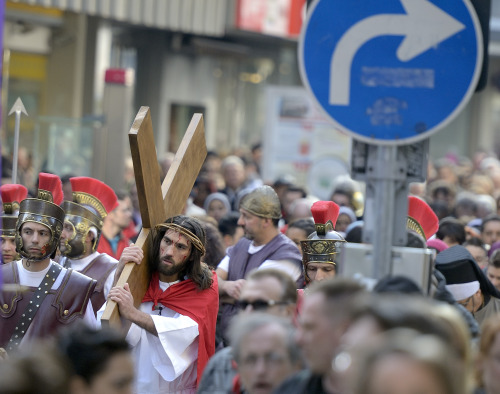JERUSALEM (AP) ― Thousands of Christians gathered near Jerusalem’s Church of the Holy Sepulcher for Easter Saturday and marched in processions brimming with tradition, taking turns to pray in the site where they believe Jesus was slain and buried.
Easter Saturday is a day of reflection and waiting for many Christians, who believe Jesus was crucified on Friday and rose from the dead on Sunday.
“This day is very important for us. It’s the waiting for the great celebration of the resurrection,” said Father Ibrahim Shomali, a Palestinian Christian priest from the nearby town of Beit Jala.
Thousands marched through Jerusalem’s cobbled old city Saturday morning.
They were led by Palestinian guards in black costumes richly embroidered with gold, topped with scarlet rimless hats. They rhythmically pounded their staffs on the cobblestone ground, providing a beat for believers to march. The guards, “Qawwasin” in Arabic or “Marksmen” in English, are a leftover vestige from when Ottoman Muslims ruled the Holy Land, Father Shomali said.
According to a series of traditions established over hundreds of years of accommodation between different Christian sects and the region’s ever-changing rulers, the Qawwasin march at the head of the Easter Saturday procession. Their job was formerly to protect Jerusalem’s Catholic patriarch. Now, it is a ceremonial role.
 |
Thousands of believers remember the passion of Jesus Christ during Germany’s biggest Good Friday procession in Wuppertal, Germany on Friday. (AP-Yonhap News) |
They were followed by Franciscan monks in plain brown robes, clerics in black garb, and then laymen.
The believers congregated for prayer in the Holy Sepulcher, which many Christians believe was built on the site where Jesus was crucified and buried.
“This is the place where Jesus is in his tomb, this is the place, a magnet of the world,” said worshipper Jim Carnie of New York City, New York. “The power of this place, to be here, it has to be experienced.”
The Holy Sepulcher is a complex of cave-like rooms, winding corridors, a soaring domed roof, and ornate decorations alongside broken furniture.
Different, often rival, Christian sects control different parts of the Sepulcher, and they have been unable to agree on maintenance and upkeep in some areas.
Catholic and Protestant groups that observe the Gregorian calendar took turns praying in the Holy Sepulcher on Saturday.
Eastern Orthodox churches and others who follow the older Julian calendar will mark Easter a week from now.
At an afternoon service in Bethlehem, clergymen were dressed in white frocks and Palestinian worshippers held candles in the Nativity Church, built on the spot believed to be the site of Jesus’ birth. Palestinian Christians in the Gaza Strip also held a vigil.
The Holy Week commemorations culminate tomorrow on Easter Sunday. The Latin Patriarch, the top Roman Catholic official in the Holy Land, will enter ceremoniously to the Holy Sepulcher and lead Easter mass. Protestants will hold their own morning Easter service outside Jerusalem’s walled Old City in the Garden Tomb, which some identify as the site of Jesus’ burial.
The Old City of Jerusalem will host a jumble of Christian masses and commemorations Sunday, as believers from Eastern Orthodox churches mark the beginning of Holy Week at the same time that Catholics and Protestants celebrate the end of Holy Week.
There are about 110,000 Arab Christians in the Holy land, along with thousands of Christian foreign workers, asylum seekers, and Russian-speaking immigrants.
They are accompanied by tens of thousands of Christian pilgrims from outside the region who flock to Jerusalem and the Holy Land for Easter rites.








